Business and Business Environment: UK Supermarket Sector Report
VerifiedAdded on 2020/10/05
|13
|3746
|54
Report
AI Summary
This report delves into the intricacies of the business environment, examining various types of organizations across different sectors, including public and private entities, profit and non-profit organizations, and micro, small, medium, and large-sized enterprises. It explores different organizational structures such as divisional, functional, and matrix structures, highlighting their complexities and suitability for international, transnational, and global companies. The report emphasizes the interrelationships between organizational functions like finance, R&D, marketing, production, sales, and HR, underscoring the importance of coordination for achieving overall efficiency and profitability. Furthermore, the report conducts a PESTLE analysis of the UK retail supermarket sector, followed by a SWOT analysis of Sainsbury's and an application of Porter's Five Forces model to assess the competitive landscape. The analysis aims to identify the strengths and weaknesses of the supermarket and the external factors that influence the business environment. The report concludes with an overview of the key findings and insights from the analysis.
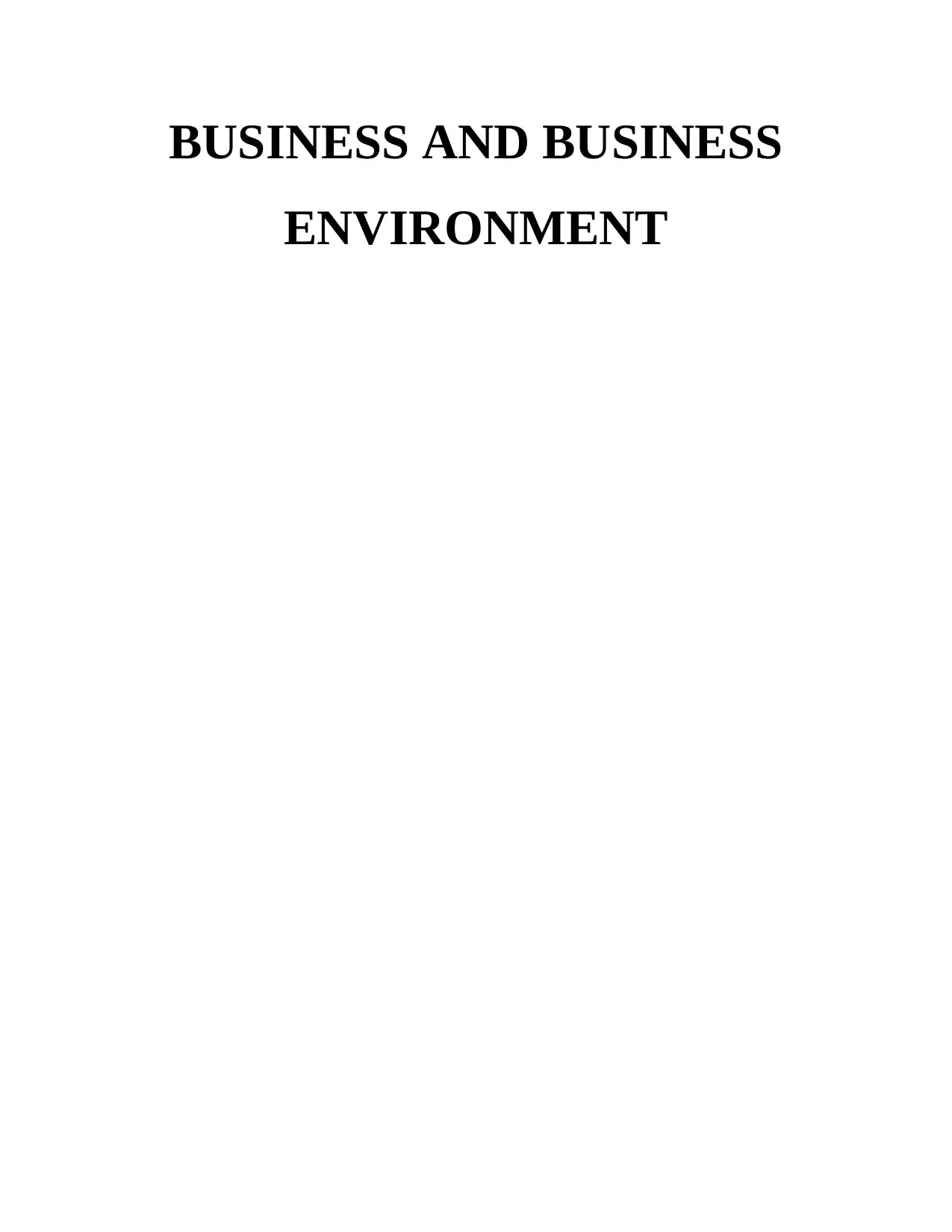
BUSINESS AND BUSINESS
ENVIRONMENT
ENVIRONMENT
Paraphrase This Document
Need a fresh take? Get an instant paraphrase of this document with our AI Paraphraser
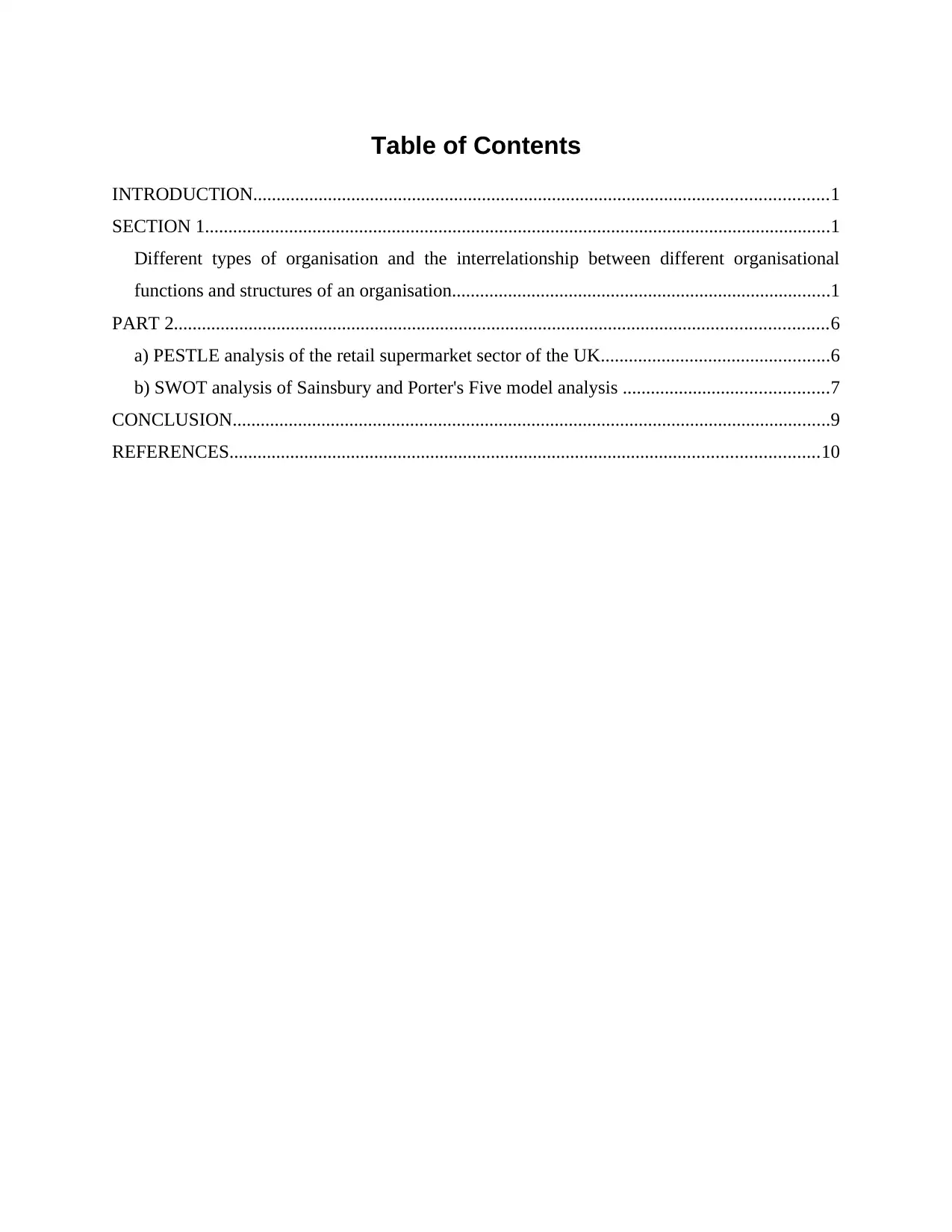
Table of Contents
INTRODUCTION...........................................................................................................................1
SECTION 1......................................................................................................................................1
Different types of organisation and the interrelationship between different organisational
functions and structures of an organisation.................................................................................1
PART 2............................................................................................................................................6
a) PESTLE analysis of the retail supermarket sector of the UK.................................................6
b) SWOT analysis of Sainsbury and Porter's Five model analysis ............................................7
CONCLUSION................................................................................................................................9
REFERENCES..............................................................................................................................10
INTRODUCTION...........................................................................................................................1
SECTION 1......................................................................................................................................1
Different types of organisation and the interrelationship between different organisational
functions and structures of an organisation.................................................................................1
PART 2............................................................................................................................................6
a) PESTLE analysis of the retail supermarket sector of the UK.................................................6
b) SWOT analysis of Sainsbury and Porter's Five model analysis ............................................7
CONCLUSION................................................................................................................................9
REFERENCES..............................................................................................................................10
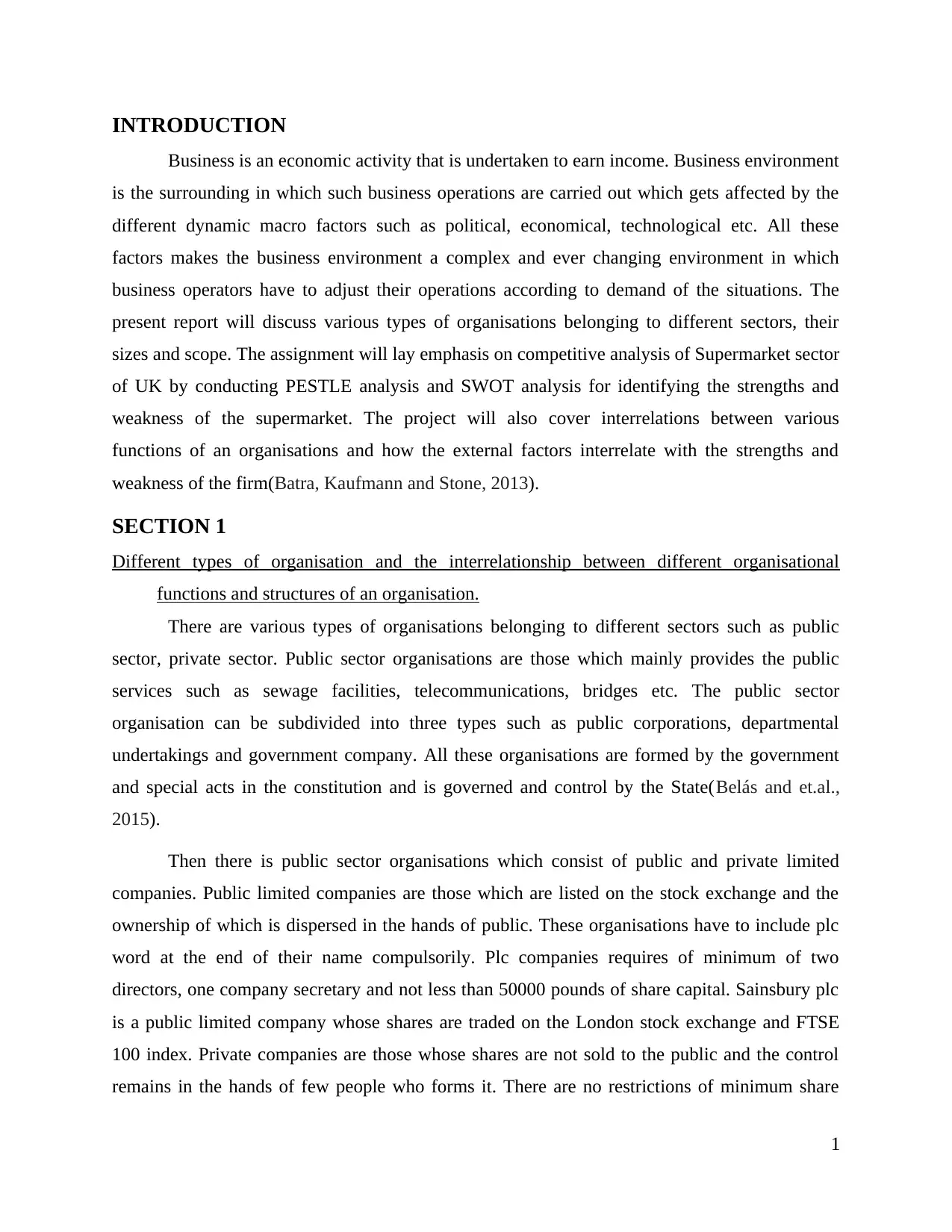
INTRODUCTION
Business is an economic activity that is undertaken to earn income. Business environment
is the surrounding in which such business operations are carried out which gets affected by the
different dynamic macro factors such as political, economical, technological etc. All these
factors makes the business environment a complex and ever changing environment in which
business operators have to adjust their operations according to demand of the situations. The
present report will discuss various types of organisations belonging to different sectors, their
sizes and scope. The assignment will lay emphasis on competitive analysis of Supermarket sector
of UK by conducting PESTLE analysis and SWOT analysis for identifying the strengths and
weakness of the supermarket. The project will also cover interrelations between various
functions of an organisations and how the external factors interrelate with the strengths and
weakness of the firm(Batra, Kaufmann and Stone, 2013).
SECTION 1
Different types of organisation and the interrelationship between different organisational
functions and structures of an organisation.
There are various types of organisations belonging to different sectors such as public
sector, private sector. Public sector organisations are those which mainly provides the public
services such as sewage facilities, telecommunications, bridges etc. The public sector
organisation can be subdivided into three types such as public corporations, departmental
undertakings and government company. All these organisations are formed by the government
and special acts in the constitution and is governed and control by the State(Belás and et.al.,
2015).
Then there is public sector organisations which consist of public and private limited
companies. Public limited companies are those which are listed on the stock exchange and the
ownership of which is dispersed in the hands of public. These organisations have to include plc
word at the end of their name compulsorily. Plc companies requires of minimum of two
directors, one company secretary and not less than 50000 pounds of share capital. Sainsbury plc
is a public limited company whose shares are traded on the London stock exchange and FTSE
100 index. Private companies are those whose shares are not sold to the public and the control
remains in the hands of few people who forms it. There are no restrictions of minimum share
1
Business is an economic activity that is undertaken to earn income. Business environment
is the surrounding in which such business operations are carried out which gets affected by the
different dynamic macro factors such as political, economical, technological etc. All these
factors makes the business environment a complex and ever changing environment in which
business operators have to adjust their operations according to demand of the situations. The
present report will discuss various types of organisations belonging to different sectors, their
sizes and scope. The assignment will lay emphasis on competitive analysis of Supermarket sector
of UK by conducting PESTLE analysis and SWOT analysis for identifying the strengths and
weakness of the supermarket. The project will also cover interrelations between various
functions of an organisations and how the external factors interrelate with the strengths and
weakness of the firm(Batra, Kaufmann and Stone, 2013).
SECTION 1
Different types of organisation and the interrelationship between different organisational
functions and structures of an organisation.
There are various types of organisations belonging to different sectors such as public
sector, private sector. Public sector organisations are those which mainly provides the public
services such as sewage facilities, telecommunications, bridges etc. The public sector
organisation can be subdivided into three types such as public corporations, departmental
undertakings and government company. All these organisations are formed by the government
and special acts in the constitution and is governed and control by the State(Belás and et.al.,
2015).
Then there is public sector organisations which consist of public and private limited
companies. Public limited companies are those which are listed on the stock exchange and the
ownership of which is dispersed in the hands of public. These organisations have to include plc
word at the end of their name compulsorily. Plc companies requires of minimum of two
directors, one company secretary and not less than 50000 pounds of share capital. Sainsbury plc
is a public limited company whose shares are traded on the London stock exchange and FTSE
100 index. Private companies are those whose shares are not sold to the public and the control
remains in the hands of few people who forms it. There are no restrictions of minimum share
1
⊘ This is a preview!⊘
Do you want full access?
Subscribe today to unlock all pages.

Trusted by 1+ million students worldwide
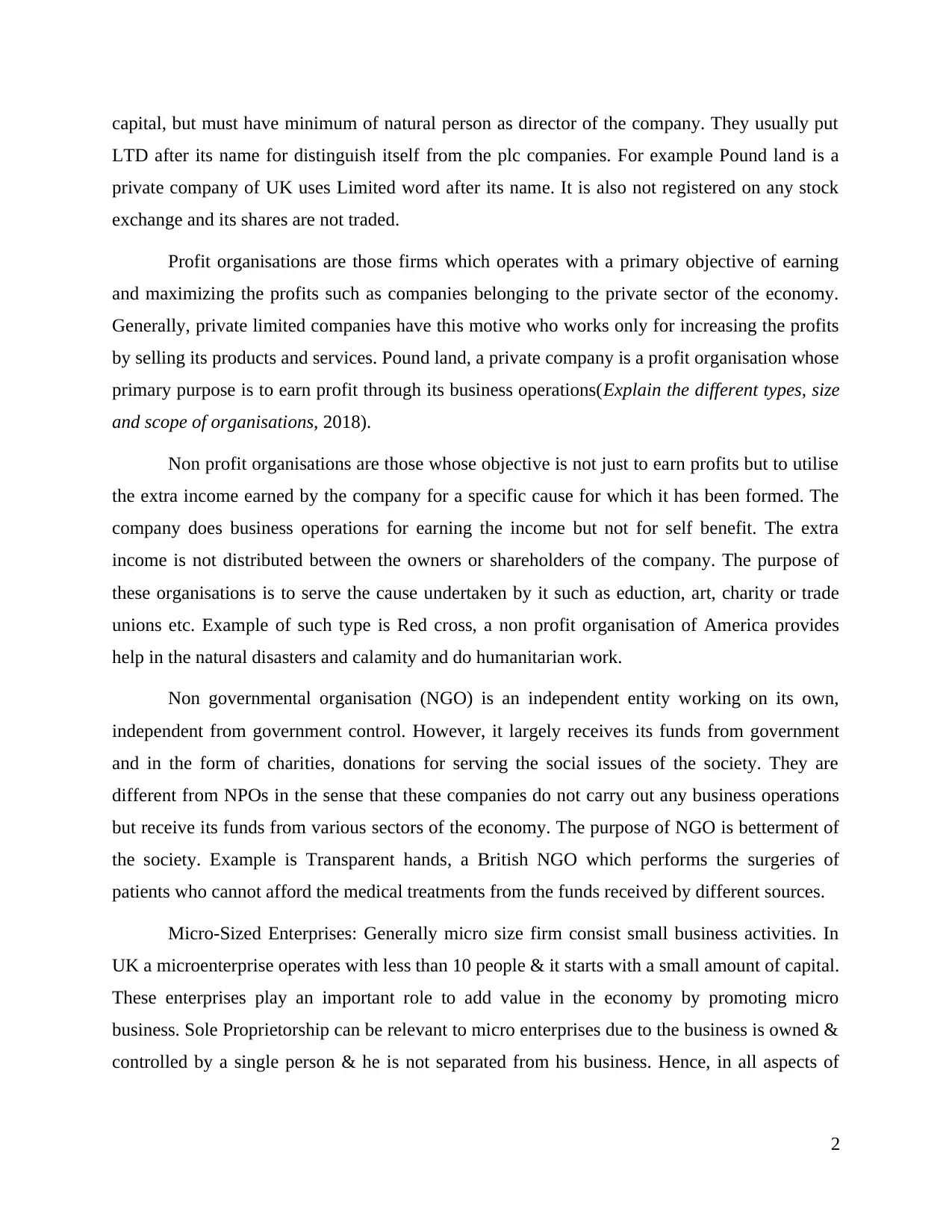
capital, but must have minimum of natural person as director of the company. They usually put
LTD after its name for distinguish itself from the plc companies. For example Pound land is a
private company of UK uses Limited word after its name. It is also not registered on any stock
exchange and its shares are not traded.
Profit organisations are those firms which operates with a primary objective of earning
and maximizing the profits such as companies belonging to the private sector of the economy.
Generally, private limited companies have this motive who works only for increasing the profits
by selling its products and services. Pound land, a private company is a profit organisation whose
primary purpose is to earn profit through its business operations(Explain the different types, size
and scope of organisations, 2018).
Non profit organisations are those whose objective is not just to earn profits but to utilise
the extra income earned by the company for a specific cause for which it has been formed. The
company does business operations for earning the income but not for self benefit. The extra
income is not distributed between the owners or shareholders of the company. The purpose of
these organisations is to serve the cause undertaken by it such as eduction, art, charity or trade
unions etc. Example of such type is Red cross, a non profit organisation of America provides
help in the natural disasters and calamity and do humanitarian work.
Non governmental organisation (NGO) is an independent entity working on its own,
independent from government control. However, it largely receives its funds from government
and in the form of charities, donations for serving the social issues of the society. They are
different from NPOs in the sense that these companies do not carry out any business operations
but receive its funds from various sectors of the economy. The purpose of NGO is betterment of
the society. Example is Transparent hands, a British NGO which performs the surgeries of
patients who cannot afford the medical treatments from the funds received by different sources.
Micro-Sized Enterprises: Generally micro size firm consist small business activities. In
UK a microenterprise operates with less than 10 people & it starts with a small amount of capital.
These enterprises play an important role to add value in the economy by promoting micro
business. Sole Proprietorship can be relevant to micro enterprises due to the business is owned &
controlled by a single person & he is not separated from his business. Hence, in all aspects of
2
LTD after its name for distinguish itself from the plc companies. For example Pound land is a
private company of UK uses Limited word after its name. It is also not registered on any stock
exchange and its shares are not traded.
Profit organisations are those firms which operates with a primary objective of earning
and maximizing the profits such as companies belonging to the private sector of the economy.
Generally, private limited companies have this motive who works only for increasing the profits
by selling its products and services. Pound land, a private company is a profit organisation whose
primary purpose is to earn profit through its business operations(Explain the different types, size
and scope of organisations, 2018).
Non profit organisations are those whose objective is not just to earn profits but to utilise
the extra income earned by the company for a specific cause for which it has been formed. The
company does business operations for earning the income but not for self benefit. The extra
income is not distributed between the owners or shareholders of the company. The purpose of
these organisations is to serve the cause undertaken by it such as eduction, art, charity or trade
unions etc. Example of such type is Red cross, a non profit organisation of America provides
help in the natural disasters and calamity and do humanitarian work.
Non governmental organisation (NGO) is an independent entity working on its own,
independent from government control. However, it largely receives its funds from government
and in the form of charities, donations for serving the social issues of the society. They are
different from NPOs in the sense that these companies do not carry out any business operations
but receive its funds from various sectors of the economy. The purpose of NGO is betterment of
the society. Example is Transparent hands, a British NGO which performs the surgeries of
patients who cannot afford the medical treatments from the funds received by different sources.
Micro-Sized Enterprises: Generally micro size firm consist small business activities. In
UK a microenterprise operates with less than 10 people & it starts with a small amount of capital.
These enterprises play an important role to add value in the economy by promoting micro
business. Sole Proprietorship can be relevant to micro enterprises due to the business is owned &
controlled by a single person & he is not separated from his business. Hence, in all aspects of
2
Paraphrase This Document
Need a fresh take? Get an instant paraphrase of this document with our AI Paraphraser
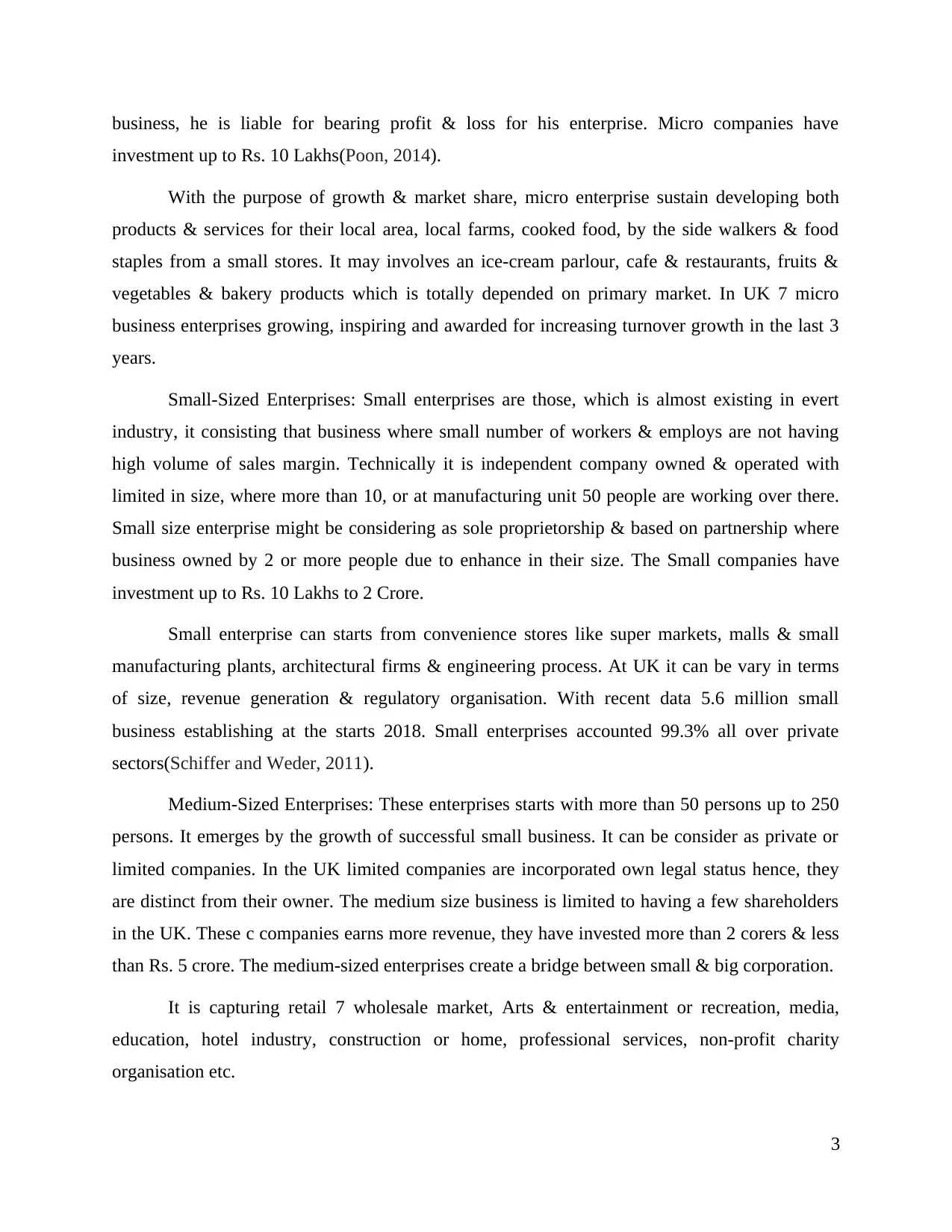
business, he is liable for bearing profit & loss for his enterprise. Micro companies have
investment up to Rs. 10 Lakhs(Poon, 2014).
With the purpose of growth & market share, micro enterprise sustain developing both
products & services for their local area, local farms, cooked food, by the side walkers & food
staples from a small stores. It may involves an ice-cream parlour, cafe & restaurants, fruits &
vegetables & bakery products which is totally depended on primary market. In UK 7 micro
business enterprises growing, inspiring and awarded for increasing turnover growth in the last 3
years.
Small-Sized Enterprises: Small enterprises are those, which is almost existing in evert
industry, it consisting that business where small number of workers & employs are not having
high volume of sales margin. Technically it is independent company owned & operated with
limited in size, where more than 10, or at manufacturing unit 50 people are working over there.
Small size enterprise might be considering as sole proprietorship & based on partnership where
business owned by 2 or more people due to enhance in their size. The Small companies have
investment up to Rs. 10 Lakhs to 2 Crore.
Small enterprise can starts from convenience stores like super markets, malls & small
manufacturing plants, architectural firms & engineering process. At UK it can be vary in terms
of size, revenue generation & regulatory organisation. With recent data 5.6 million small
business establishing at the starts 2018. Small enterprises accounted 99.3% all over private
sectors(Schiffer and Weder, 2011).
Medium-Sized Enterprises: These enterprises starts with more than 50 persons up to 250
persons. It emerges by the growth of successful small business. It can be consider as private or
limited companies. In the UK limited companies are incorporated own legal status hence, they
are distinct from their owner. The medium size business is limited to having a few shareholders
in the UK. These c companies earns more revenue, they have invested more than 2 corers & less
than Rs. 5 crore. The medium-sized enterprises create a bridge between small & big corporation.
It is capturing retail 7 wholesale market, Arts & entertainment or recreation, media,
education, hotel industry, construction or home, professional services, non-profit charity
organisation etc.
3
investment up to Rs. 10 Lakhs(Poon, 2014).
With the purpose of growth & market share, micro enterprise sustain developing both
products & services for their local area, local farms, cooked food, by the side walkers & food
staples from a small stores. It may involves an ice-cream parlour, cafe & restaurants, fruits &
vegetables & bakery products which is totally depended on primary market. In UK 7 micro
business enterprises growing, inspiring and awarded for increasing turnover growth in the last 3
years.
Small-Sized Enterprises: Small enterprises are those, which is almost existing in evert
industry, it consisting that business where small number of workers & employs are not having
high volume of sales margin. Technically it is independent company owned & operated with
limited in size, where more than 10, or at manufacturing unit 50 people are working over there.
Small size enterprise might be considering as sole proprietorship & based on partnership where
business owned by 2 or more people due to enhance in their size. The Small companies have
investment up to Rs. 10 Lakhs to 2 Crore.
Small enterprise can starts from convenience stores like super markets, malls & small
manufacturing plants, architectural firms & engineering process. At UK it can be vary in terms
of size, revenue generation & regulatory organisation. With recent data 5.6 million small
business establishing at the starts 2018. Small enterprises accounted 99.3% all over private
sectors(Schiffer and Weder, 2011).
Medium-Sized Enterprises: These enterprises starts with more than 50 persons up to 250
persons. It emerges by the growth of successful small business. It can be consider as private or
limited companies. In the UK limited companies are incorporated own legal status hence, they
are distinct from their owner. The medium size business is limited to having a few shareholders
in the UK. These c companies earns more revenue, they have invested more than 2 corers & less
than Rs. 5 crore. The medium-sized enterprises create a bridge between small & big corporation.
It is capturing retail 7 wholesale market, Arts & entertainment or recreation, media,
education, hotel industry, construction or home, professional services, non-profit charity
organisation etc.
3
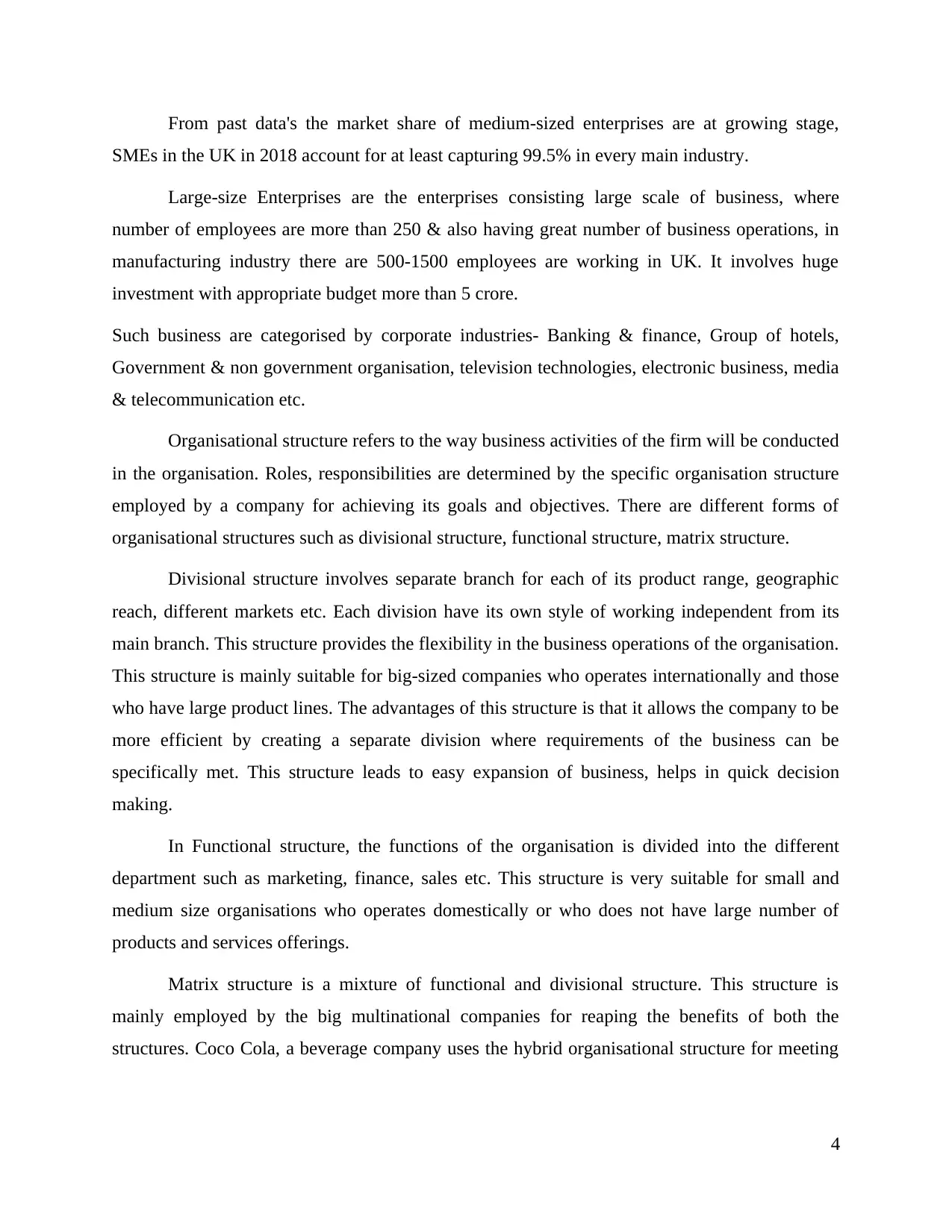
From past data's the market share of medium-sized enterprises are at growing stage,
SMEs in the UK in 2018 account for at least capturing 99.5% in every main industry.
Large-size Enterprises are the enterprises consisting large scale of business, where
number of employees are more than 250 & also having great number of business operations, in
manufacturing industry there are 500-1500 employees are working in UK. It involves huge
investment with appropriate budget more than 5 crore.
Such business are categorised by corporate industries- Banking & finance, Group of hotels,
Government & non government organisation, television technologies, electronic business, media
& telecommunication etc.
Organisational structure refers to the way business activities of the firm will be conducted
in the organisation. Roles, responsibilities are determined by the specific organisation structure
employed by a company for achieving its goals and objectives. There are different forms of
organisational structures such as divisional structure, functional structure, matrix structure.
Divisional structure involves separate branch for each of its product range, geographic
reach, different markets etc. Each division have its own style of working independent from its
main branch. This structure provides the flexibility in the business operations of the organisation.
This structure is mainly suitable for big-sized companies who operates internationally and those
who have large product lines. The advantages of this structure is that it allows the company to be
more efficient by creating a separate division where requirements of the business can be
specifically met. This structure leads to easy expansion of business, helps in quick decision
making.
In Functional structure, the functions of the organisation is divided into the different
department such as marketing, finance, sales etc. This structure is very suitable for small and
medium size organisations who operates domestically or who does not have large number of
products and services offerings.
Matrix structure is a mixture of functional and divisional structure. This structure is
mainly employed by the big multinational companies for reaping the benefits of both the
structures. Coco Cola, a beverage company uses the hybrid organisational structure for meeting
4
SMEs in the UK in 2018 account for at least capturing 99.5% in every main industry.
Large-size Enterprises are the enterprises consisting large scale of business, where
number of employees are more than 250 & also having great number of business operations, in
manufacturing industry there are 500-1500 employees are working in UK. It involves huge
investment with appropriate budget more than 5 crore.
Such business are categorised by corporate industries- Banking & finance, Group of hotels,
Government & non government organisation, television technologies, electronic business, media
& telecommunication etc.
Organisational structure refers to the way business activities of the firm will be conducted
in the organisation. Roles, responsibilities are determined by the specific organisation structure
employed by a company for achieving its goals and objectives. There are different forms of
organisational structures such as divisional structure, functional structure, matrix structure.
Divisional structure involves separate branch for each of its product range, geographic
reach, different markets etc. Each division have its own style of working independent from its
main branch. This structure provides the flexibility in the business operations of the organisation.
This structure is mainly suitable for big-sized companies who operates internationally and those
who have large product lines. The advantages of this structure is that it allows the company to be
more efficient by creating a separate division where requirements of the business can be
specifically met. This structure leads to easy expansion of business, helps in quick decision
making.
In Functional structure, the functions of the organisation is divided into the different
department such as marketing, finance, sales etc. This structure is very suitable for small and
medium size organisations who operates domestically or who does not have large number of
products and services offerings.
Matrix structure is a mixture of functional and divisional structure. This structure is
mainly employed by the big multinational companies for reaping the benefits of both the
structures. Coco Cola, a beverage company uses the hybrid organisational structure for meeting
4
⊘ This is a preview!⊘
Do you want full access?
Subscribe today to unlock all pages.

Trusted by 1+ million students worldwide
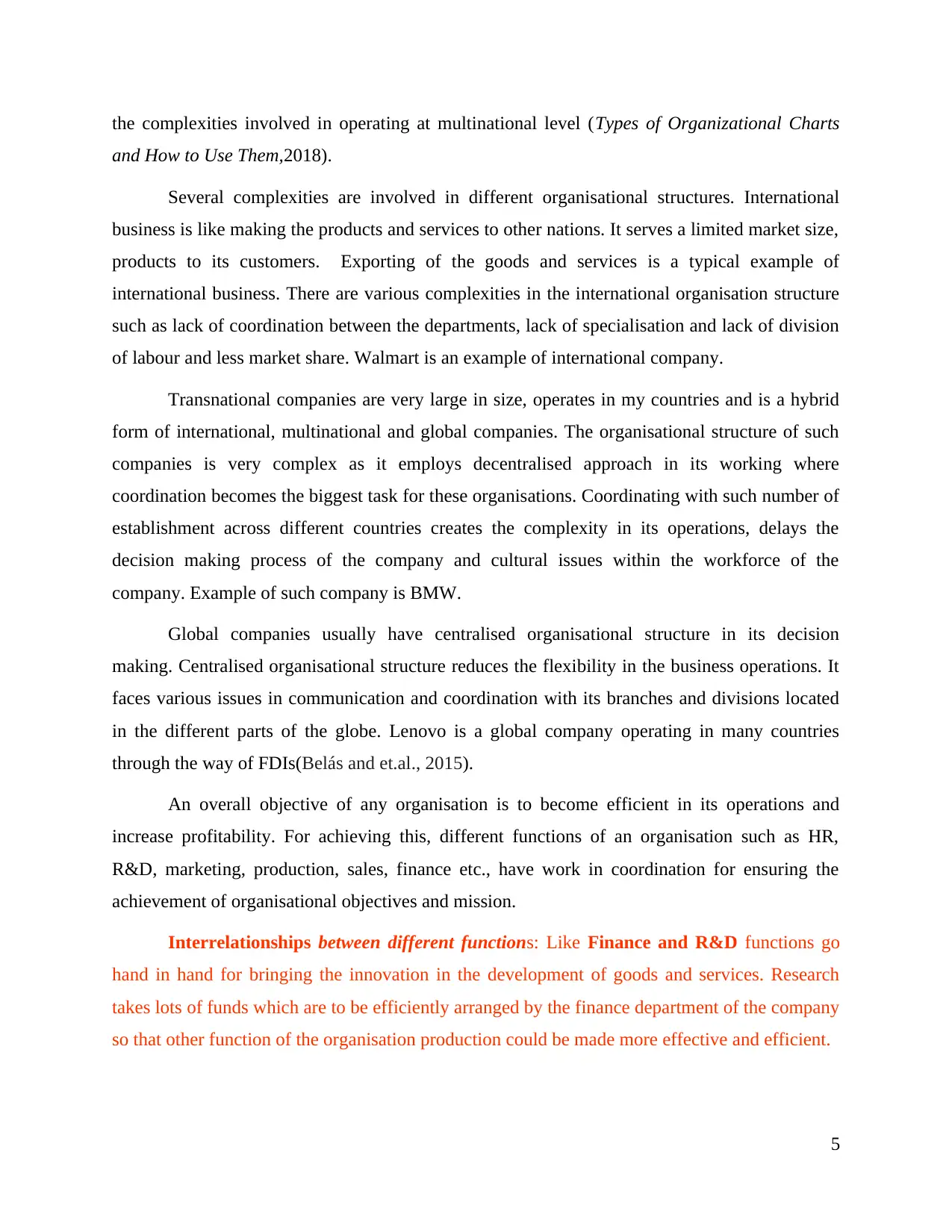
the complexities involved in operating at multinational level (Types of Organizational Charts
and How to Use Them,2018).
Several complexities are involved in different organisational structures. International
business is like making the products and services to other nations. It serves a limited market size,
products to its customers. Exporting of the goods and services is a typical example of
international business. There are various complexities in the international organisation structure
such as lack of coordination between the departments, lack of specialisation and lack of division
of labour and less market share. Walmart is an example of international company.
Transnational companies are very large in size, operates in my countries and is a hybrid
form of international, multinational and global companies. The organisational structure of such
companies is very complex as it employs decentralised approach in its working where
coordination becomes the biggest task for these organisations. Coordinating with such number of
establishment across different countries creates the complexity in its operations, delays the
decision making process of the company and cultural issues within the workforce of the
company. Example of such company is BMW.
Global companies usually have centralised organisational structure in its decision
making. Centralised organisational structure reduces the flexibility in the business operations. It
faces various issues in communication and coordination with its branches and divisions located
in the different parts of the globe. Lenovo is a global company operating in many countries
through the way of FDIs(Belás and et.al., 2015).
An overall objective of any organisation is to become efficient in its operations and
increase profitability. For achieving this, different functions of an organisation such as HR,
R&D, marketing, production, sales, finance etc., have work in coordination for ensuring the
achievement of organisational objectives and mission.
Interrelationships between different functions: Like Finance and R&D functions go
hand in hand for bringing the innovation in the development of goods and services. Research
takes lots of funds which are to be efficiently arranged by the finance department of the company
so that other function of the organisation production could be made more effective and efficient.
5
and How to Use Them,2018).
Several complexities are involved in different organisational structures. International
business is like making the products and services to other nations. It serves a limited market size,
products to its customers. Exporting of the goods and services is a typical example of
international business. There are various complexities in the international organisation structure
such as lack of coordination between the departments, lack of specialisation and lack of division
of labour and less market share. Walmart is an example of international company.
Transnational companies are very large in size, operates in my countries and is a hybrid
form of international, multinational and global companies. The organisational structure of such
companies is very complex as it employs decentralised approach in its working where
coordination becomes the biggest task for these organisations. Coordinating with such number of
establishment across different countries creates the complexity in its operations, delays the
decision making process of the company and cultural issues within the workforce of the
company. Example of such company is BMW.
Global companies usually have centralised organisational structure in its decision
making. Centralised organisational structure reduces the flexibility in the business operations. It
faces various issues in communication and coordination with its branches and divisions located
in the different parts of the globe. Lenovo is a global company operating in many countries
through the way of FDIs(Belás and et.al., 2015).
An overall objective of any organisation is to become efficient in its operations and
increase profitability. For achieving this, different functions of an organisation such as HR,
R&D, marketing, production, sales, finance etc., have work in coordination for ensuring the
achievement of organisational objectives and mission.
Interrelationships between different functions: Like Finance and R&D functions go
hand in hand for bringing the innovation in the development of goods and services. Research
takes lots of funds which are to be efficiently arranged by the finance department of the company
so that other function of the organisation production could be made more effective and efficient.
5
Paraphrase This Document
Need a fresh take? Get an instant paraphrase of this document with our AI Paraphraser
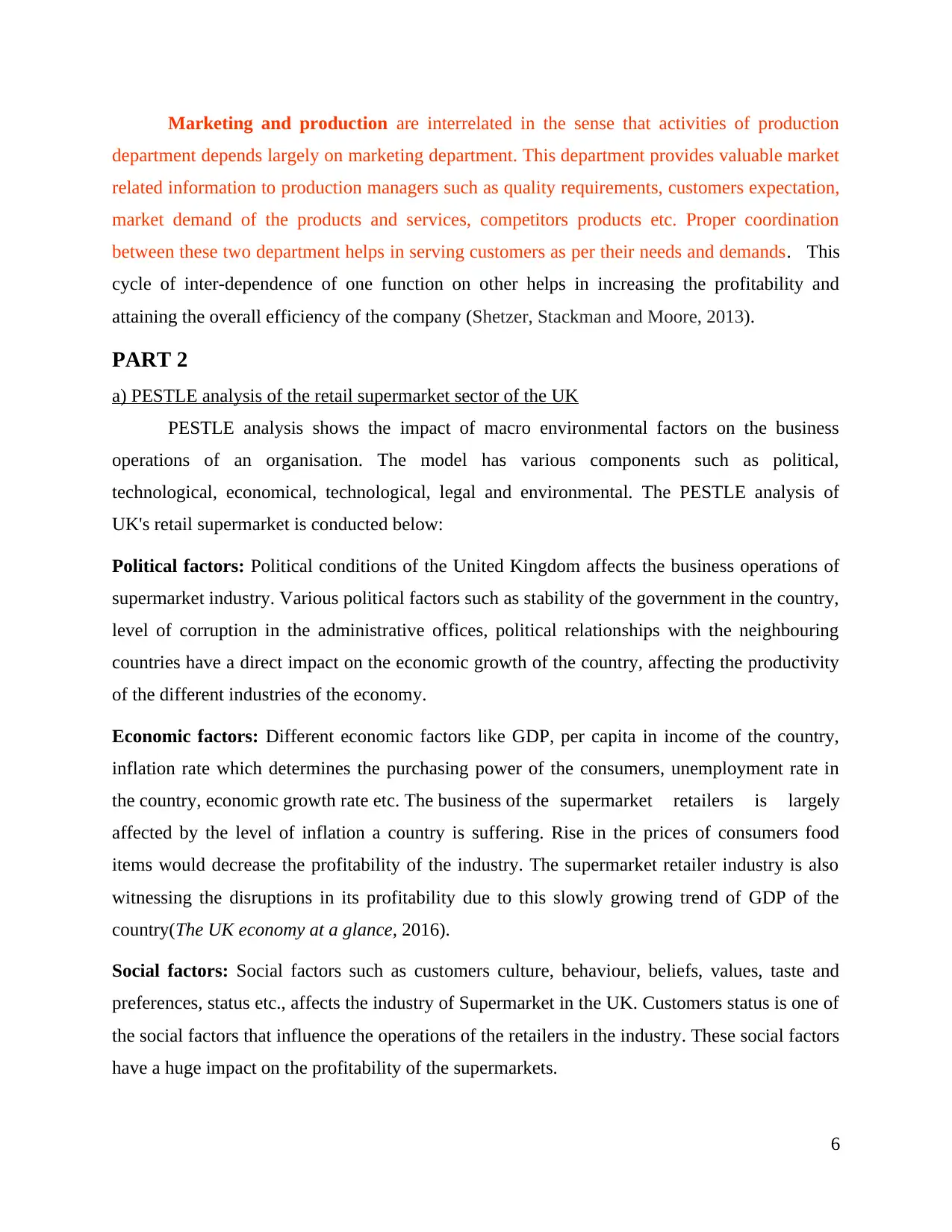
Marketing and production are interrelated in the sense that activities of production
department depends largely on marketing department. This department provides valuable market
related information to production managers such as quality requirements, customers expectation,
market demand of the products and services, competitors products etc. Proper coordination
between these two department helps in serving customers as per their needs and demands. This
cycle of inter-dependence of one function on other helps in increasing the profitability and
attaining the overall efficiency of the company (Shetzer, Stackman and Moore, 2013).
PART 2
a) PESTLE analysis of the retail supermarket sector of the UK
PESTLE analysis shows the impact of macro environmental factors on the business
operations of an organisation. The model has various components such as political,
technological, economical, technological, legal and environmental. The PESTLE analysis of
UK's retail supermarket is conducted below:
Political factors: Political conditions of the United Kingdom affects the business operations of
supermarket industry. Various political factors such as stability of the government in the country,
level of corruption in the administrative offices, political relationships with the neighbouring
countries have a direct impact on the economic growth of the country, affecting the productivity
of the different industries of the economy.
Economic factors: Different economic factors like GDP, per capita in income of the country,
inflation rate which determines the purchasing power of the consumers, unemployment rate in
the country, economic growth rate etc. The business of the supermarket retailers is largely
affected by the level of inflation a country is suffering. Rise in the prices of consumers food
items would decrease the profitability of the industry. The supermarket retailer industry is also
witnessing the disruptions in its profitability due to this slowly growing trend of GDP of the
country(The UK economy at a glance, 2016).
Social factors: Social factors such as customers culture, behaviour, beliefs, values, taste and
preferences, status etc., affects the industry of Supermarket in the UK. Customers status is one of
the social factors that influence the operations of the retailers in the industry. These social factors
have a huge impact on the profitability of the supermarkets.
6
department depends largely on marketing department. This department provides valuable market
related information to production managers such as quality requirements, customers expectation,
market demand of the products and services, competitors products etc. Proper coordination
between these two department helps in serving customers as per their needs and demands. This
cycle of inter-dependence of one function on other helps in increasing the profitability and
attaining the overall efficiency of the company (Shetzer, Stackman and Moore, 2013).
PART 2
a) PESTLE analysis of the retail supermarket sector of the UK
PESTLE analysis shows the impact of macro environmental factors on the business
operations of an organisation. The model has various components such as political,
technological, economical, technological, legal and environmental. The PESTLE analysis of
UK's retail supermarket is conducted below:
Political factors: Political conditions of the United Kingdom affects the business operations of
supermarket industry. Various political factors such as stability of the government in the country,
level of corruption in the administrative offices, political relationships with the neighbouring
countries have a direct impact on the economic growth of the country, affecting the productivity
of the different industries of the economy.
Economic factors: Different economic factors like GDP, per capita in income of the country,
inflation rate which determines the purchasing power of the consumers, unemployment rate in
the country, economic growth rate etc. The business of the supermarket retailers is largely
affected by the level of inflation a country is suffering. Rise in the prices of consumers food
items would decrease the profitability of the industry. The supermarket retailer industry is also
witnessing the disruptions in its profitability due to this slowly growing trend of GDP of the
country(The UK economy at a glance, 2016).
Social factors: Social factors such as customers culture, behaviour, beliefs, values, taste and
preferences, status etc., affects the industry of Supermarket in the UK. Customers status is one of
the social factors that influence the operations of the retailers in the industry. These social factors
have a huge impact on the profitability of the supermarkets.
6
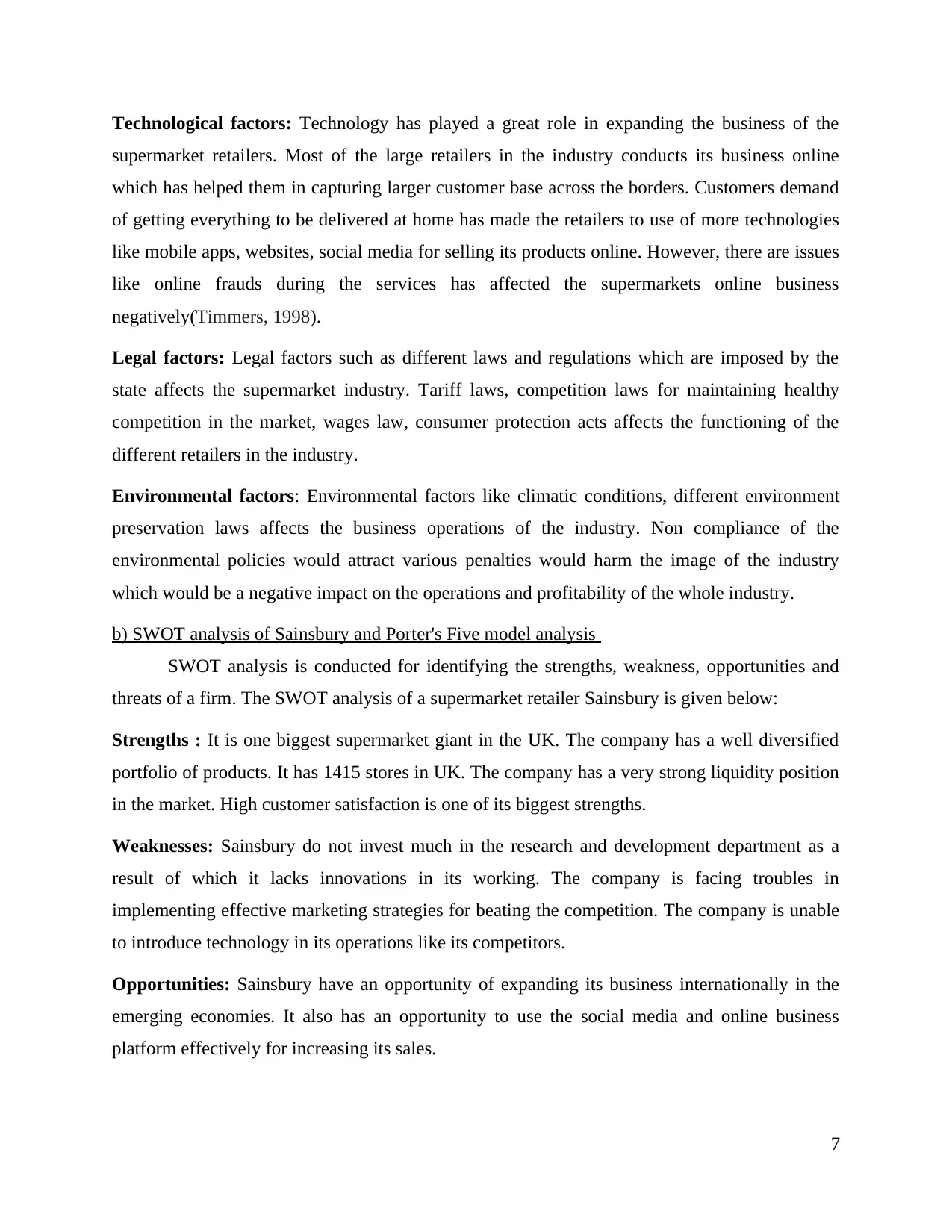
Technological factors: Technology has played a great role in expanding the business of the
supermarket retailers. Most of the large retailers in the industry conducts its business online
which has helped them in capturing larger customer base across the borders. Customers demand
of getting everything to be delivered at home has made the retailers to use of more technologies
like mobile apps, websites, social media for selling its products online. However, there are issues
like online frauds during the services has affected the supermarkets online business
negatively(Timmers, 1998).
Legal factors: Legal factors such as different laws and regulations which are imposed by the
state affects the supermarket industry. Tariff laws, competition laws for maintaining healthy
competition in the market, wages law, consumer protection acts affects the functioning of the
different retailers in the industry.
Environmental factors: Environmental factors like climatic conditions, different environment
preservation laws affects the business operations of the industry. Non compliance of the
environmental policies would attract various penalties would harm the image of the industry
which would be a negative impact on the operations and profitability of the whole industry.
b) SWOT analysis of Sainsbury and Porter's Five model analysis
SWOT analysis is conducted for identifying the strengths, weakness, opportunities and
threats of a firm. The SWOT analysis of a supermarket retailer Sainsbury is given below:
Strengths : It is one biggest supermarket giant in the UK. The company has a well diversified
portfolio of products. It has 1415 stores in UK. The company has a very strong liquidity position
in the market. High customer satisfaction is one of its biggest strengths.
Weaknesses: Sainsbury do not invest much in the research and development department as a
result of which it lacks innovations in its working. The company is facing troubles in
implementing effective marketing strategies for beating the competition. The company is unable
to introduce technology in its operations like its competitors.
Opportunities: Sainsbury have an opportunity of expanding its business internationally in the
emerging economies. It also has an opportunity to use the social media and online business
platform effectively for increasing its sales.
7
supermarket retailers. Most of the large retailers in the industry conducts its business online
which has helped them in capturing larger customer base across the borders. Customers demand
of getting everything to be delivered at home has made the retailers to use of more technologies
like mobile apps, websites, social media for selling its products online. However, there are issues
like online frauds during the services has affected the supermarkets online business
negatively(Timmers, 1998).
Legal factors: Legal factors such as different laws and regulations which are imposed by the
state affects the supermarket industry. Tariff laws, competition laws for maintaining healthy
competition in the market, wages law, consumer protection acts affects the functioning of the
different retailers in the industry.
Environmental factors: Environmental factors like climatic conditions, different environment
preservation laws affects the business operations of the industry. Non compliance of the
environmental policies would attract various penalties would harm the image of the industry
which would be a negative impact on the operations and profitability of the whole industry.
b) SWOT analysis of Sainsbury and Porter's Five model analysis
SWOT analysis is conducted for identifying the strengths, weakness, opportunities and
threats of a firm. The SWOT analysis of a supermarket retailer Sainsbury is given below:
Strengths : It is one biggest supermarket giant in the UK. The company has a well diversified
portfolio of products. It has 1415 stores in UK. The company has a very strong liquidity position
in the market. High customer satisfaction is one of its biggest strengths.
Weaknesses: Sainsbury do not invest much in the research and development department as a
result of which it lacks innovations in its working. The company is facing troubles in
implementing effective marketing strategies for beating the competition. The company is unable
to introduce technology in its operations like its competitors.
Opportunities: Sainsbury have an opportunity of expanding its business internationally in the
emerging economies. It also has an opportunity to use the social media and online business
platform effectively for increasing its sales.
7
⊘ This is a preview!⊘
Do you want full access?
Subscribe today to unlock all pages.

Trusted by 1+ million students worldwide
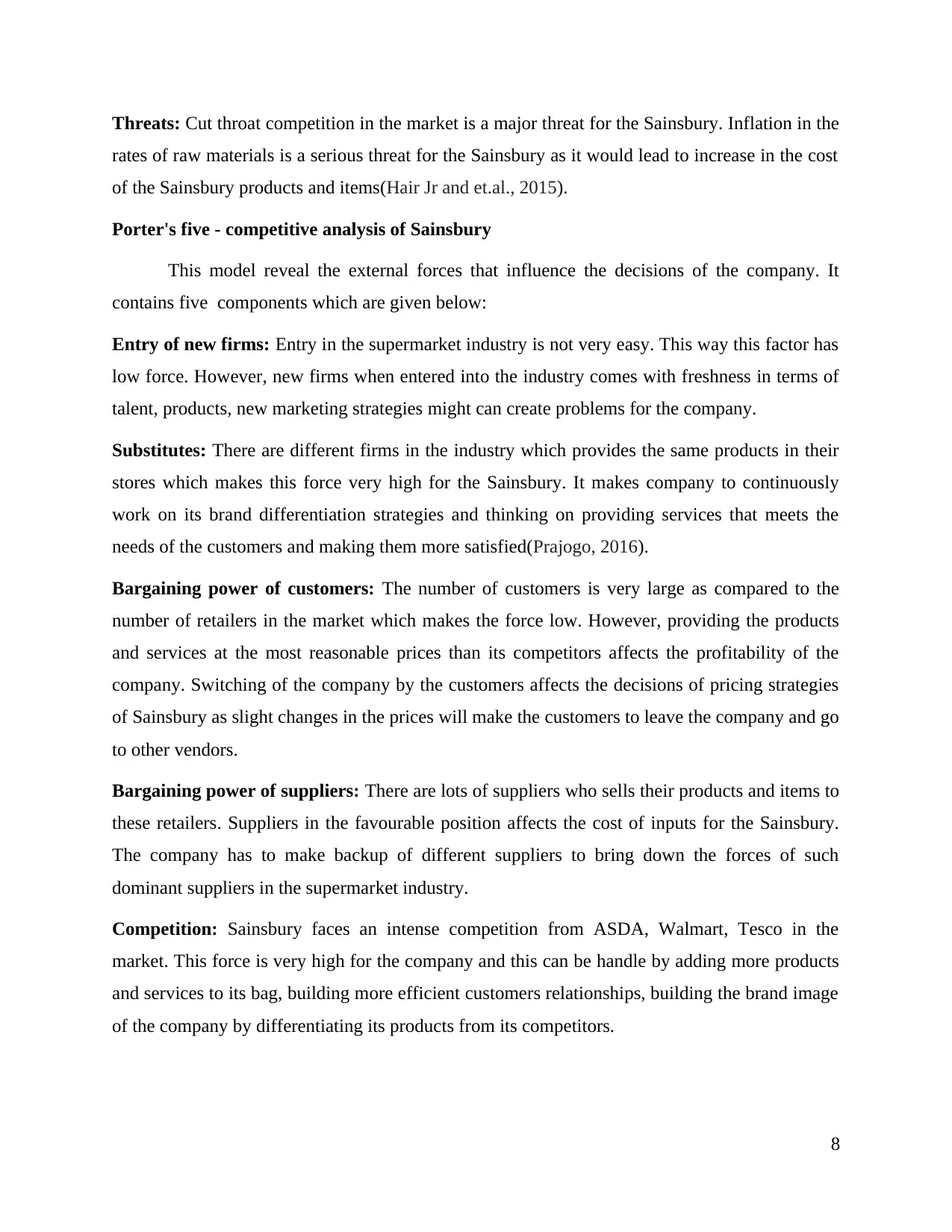
Threats: Cut throat competition in the market is a major threat for the Sainsbury. Inflation in the
rates of raw materials is a serious threat for the Sainsbury as it would lead to increase in the cost
of the Sainsbury products and items(Hair Jr and et.al., 2015).
Porter's five - competitive analysis of Sainsbury
This model reveal the external forces that influence the decisions of the company. It
contains five components which are given below:
Entry of new firms: Entry in the supermarket industry is not very easy. This way this factor has
low force. However, new firms when entered into the industry comes with freshness in terms of
talent, products, new marketing strategies might can create problems for the company.
Substitutes: There are different firms in the industry which provides the same products in their
stores which makes this force very high for the Sainsbury. It makes company to continuously
work on its brand differentiation strategies and thinking on providing services that meets the
needs of the customers and making them more satisfied(Prajogo, 2016).
Bargaining power of customers: The number of customers is very large as compared to the
number of retailers in the market which makes the force low. However, providing the products
and services at the most reasonable prices than its competitors affects the profitability of the
company. Switching of the company by the customers affects the decisions of pricing strategies
of Sainsbury as slight changes in the prices will make the customers to leave the company and go
to other vendors.
Bargaining power of suppliers: There are lots of suppliers who sells their products and items to
these retailers. Suppliers in the favourable position affects the cost of inputs for the Sainsbury.
The company has to make backup of different suppliers to bring down the forces of such
dominant suppliers in the supermarket industry.
Competition: Sainsbury faces an intense competition from ASDA, Walmart, Tesco in the
market. This force is very high for the company and this can be handle by adding more products
and services to its bag, building more efficient customers relationships, building the brand image
of the company by differentiating its products from its competitors.
8
rates of raw materials is a serious threat for the Sainsbury as it would lead to increase in the cost
of the Sainsbury products and items(Hair Jr and et.al., 2015).
Porter's five - competitive analysis of Sainsbury
This model reveal the external forces that influence the decisions of the company. It
contains five components which are given below:
Entry of new firms: Entry in the supermarket industry is not very easy. This way this factor has
low force. However, new firms when entered into the industry comes with freshness in terms of
talent, products, new marketing strategies might can create problems for the company.
Substitutes: There are different firms in the industry which provides the same products in their
stores which makes this force very high for the Sainsbury. It makes company to continuously
work on its brand differentiation strategies and thinking on providing services that meets the
needs of the customers and making them more satisfied(Prajogo, 2016).
Bargaining power of customers: The number of customers is very large as compared to the
number of retailers in the market which makes the force low. However, providing the products
and services at the most reasonable prices than its competitors affects the profitability of the
company. Switching of the company by the customers affects the decisions of pricing strategies
of Sainsbury as slight changes in the prices will make the customers to leave the company and go
to other vendors.
Bargaining power of suppliers: There are lots of suppliers who sells their products and items to
these retailers. Suppliers in the favourable position affects the cost of inputs for the Sainsbury.
The company has to make backup of different suppliers to bring down the forces of such
dominant suppliers in the supermarket industry.
Competition: Sainsbury faces an intense competition from ASDA, Walmart, Tesco in the
market. This force is very high for the company and this can be handle by adding more products
and services to its bag, building more efficient customers relationships, building the brand image
of the company by differentiating its products from its competitors.
8
Paraphrase This Document
Need a fresh take? Get an instant paraphrase of this document with our AI Paraphraser
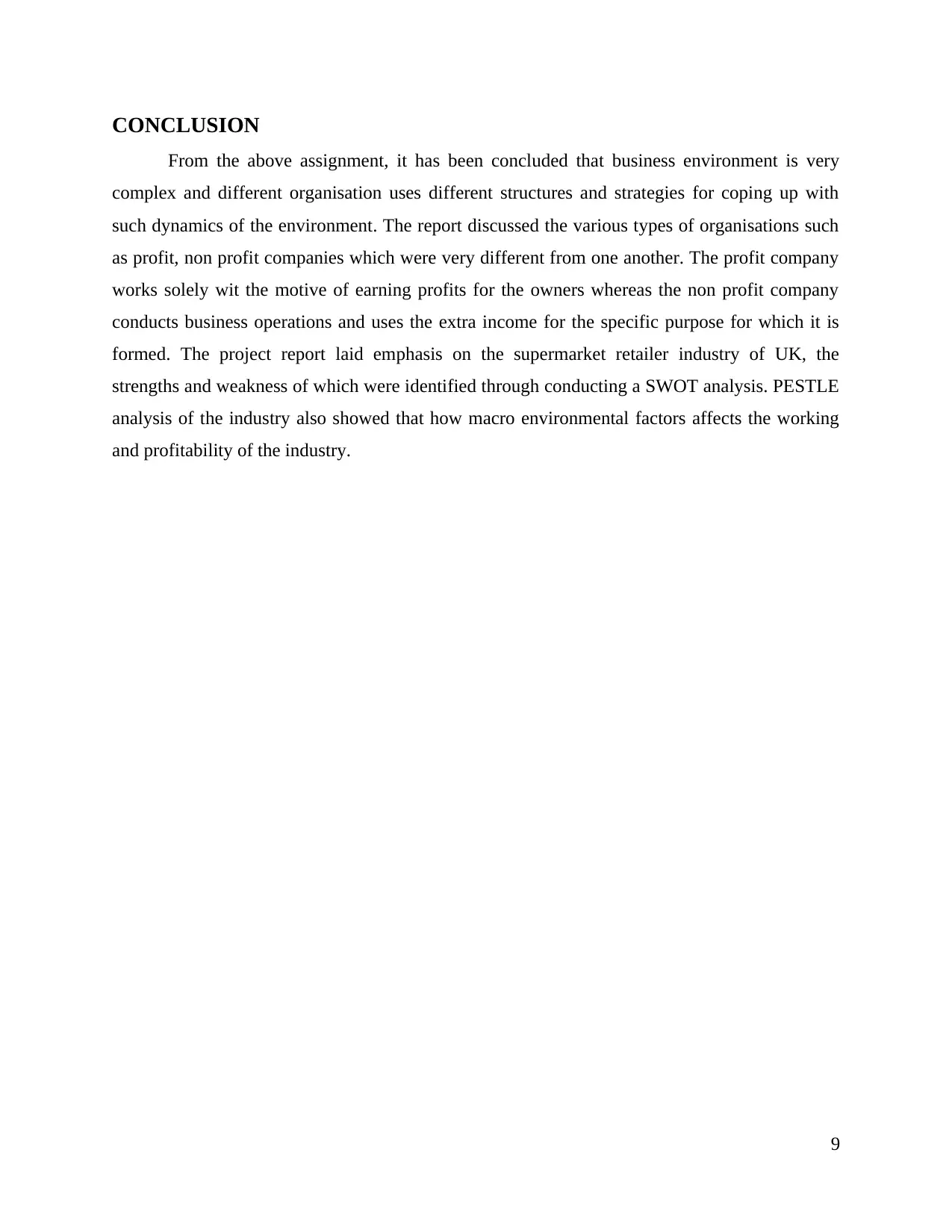
CONCLUSION
From the above assignment, it has been concluded that business environment is very
complex and different organisation uses different structures and strategies for coping up with
such dynamics of the environment. The report discussed the various types of organisations such
as profit, non profit companies which were very different from one another. The profit company
works solely wit the motive of earning profits for the owners whereas the non profit company
conducts business operations and uses the extra income for the specific purpose for which it is
formed. The project report laid emphasis on the supermarket retailer industry of UK, the
strengths and weakness of which were identified through conducting a SWOT analysis. PESTLE
analysis of the industry also showed that how macro environmental factors affects the working
and profitability of the industry.
9
From the above assignment, it has been concluded that business environment is very
complex and different organisation uses different structures and strategies for coping up with
such dynamics of the environment. The report discussed the various types of organisations such
as profit, non profit companies which were very different from one another. The profit company
works solely wit the motive of earning profits for the owners whereas the non profit company
conducts business operations and uses the extra income for the specific purpose for which it is
formed. The project report laid emphasis on the supermarket retailer industry of UK, the
strengths and weakness of which were identified through conducting a SWOT analysis. PESTLE
analysis of the industry also showed that how macro environmental factors affects the working
and profitability of the industry.
9
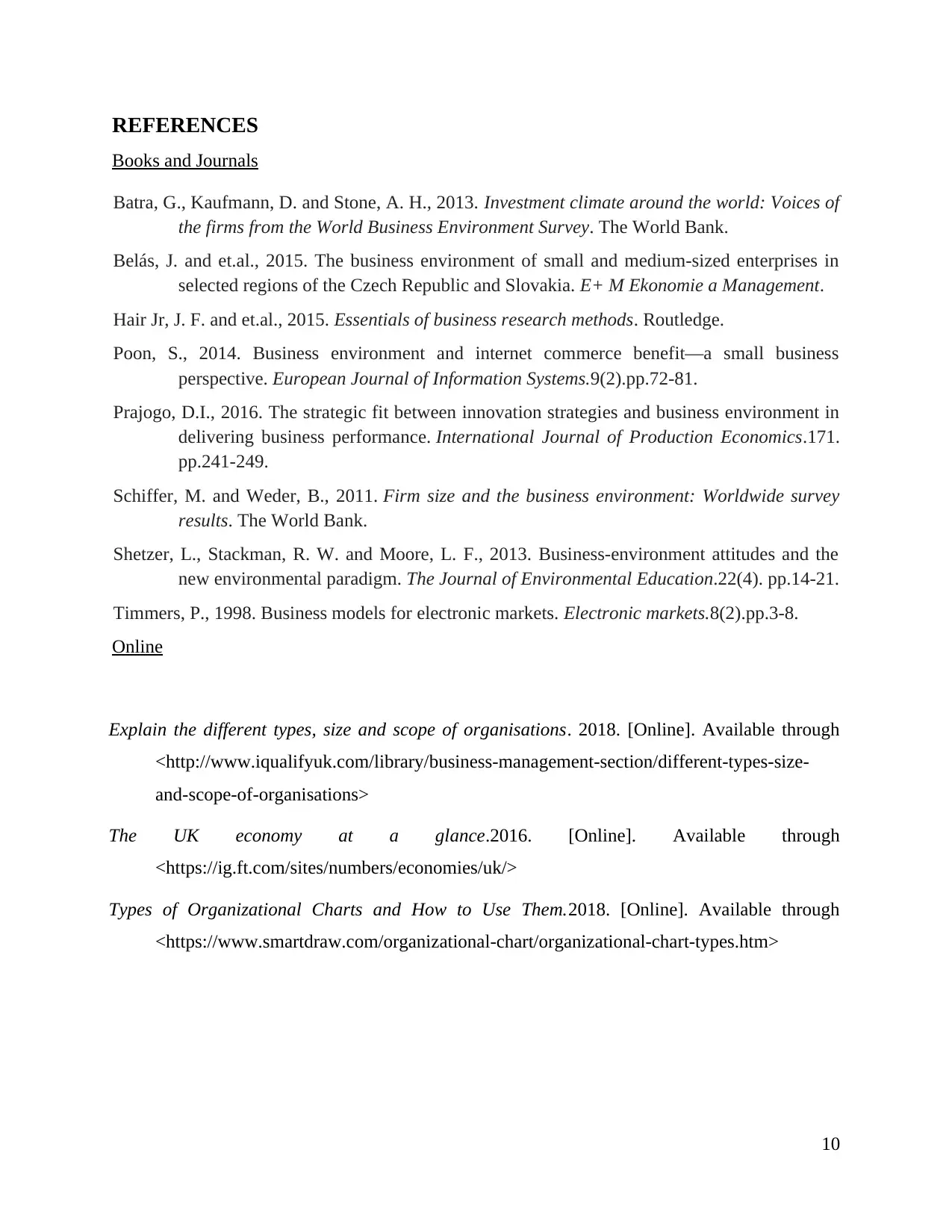
REFERENCES
Books and Journals
Batra, G., Kaufmann, D. and Stone, A. H., 2013. Investment climate around the world: Voices of
the firms from the World Business Environment Survey. The World Bank.
Belás, J. and et.al., 2015. The business environment of small and medium-sized enterprises in
selected regions of the Czech Republic and Slovakia. E+ M Ekonomie a Management.
Hair Jr, J. F. and et.al., 2015. Essentials of business research methods. Routledge.
Poon, S., 2014. Business environment and internet commerce benefit—a small business
perspective. European Journal of Information Systems.9(2).pp.72-81.
Prajogo, D.I., 2016. The strategic fit between innovation strategies and business environment in
delivering business performance. International Journal of Production Economics.171.
pp.241-249.
Schiffer, M. and Weder, B., 2011. Firm size and the business environment: Worldwide survey
results. The World Bank.
Shetzer, L., Stackman, R. W. and Moore, L. F., 2013. Business-environment attitudes and the
new environmental paradigm. The Journal of Environmental Education.22(4). pp.14-21.
Timmers, P., 1998. Business models for electronic markets. Electronic markets.8(2).pp.3-8.
Online
Explain the different types, size and scope of organisations. 2018. [Online]. Available through
<http://www.iqualifyuk.com/library/business-management-section/different-types-size-
and-scope-of-organisations>
The UK economy at a glance.2016. [Online]. Available through
<https://ig.ft.com/sites/numbers/economies/uk/>
Types of Organizational Charts and How to Use Them.2018. [Online]. Available through
<https://www.smartdraw.com/organizational-chart/organizational-chart-types.htm>
10
Books and Journals
Batra, G., Kaufmann, D. and Stone, A. H., 2013. Investment climate around the world: Voices of
the firms from the World Business Environment Survey. The World Bank.
Belás, J. and et.al., 2015. The business environment of small and medium-sized enterprises in
selected regions of the Czech Republic and Slovakia. E+ M Ekonomie a Management.
Hair Jr, J. F. and et.al., 2015. Essentials of business research methods. Routledge.
Poon, S., 2014. Business environment and internet commerce benefit—a small business
perspective. European Journal of Information Systems.9(2).pp.72-81.
Prajogo, D.I., 2016. The strategic fit between innovation strategies and business environment in
delivering business performance. International Journal of Production Economics.171.
pp.241-249.
Schiffer, M. and Weder, B., 2011. Firm size and the business environment: Worldwide survey
results. The World Bank.
Shetzer, L., Stackman, R. W. and Moore, L. F., 2013. Business-environment attitudes and the
new environmental paradigm. The Journal of Environmental Education.22(4). pp.14-21.
Timmers, P., 1998. Business models for electronic markets. Electronic markets.8(2).pp.3-8.
Online
Explain the different types, size and scope of organisations. 2018. [Online]. Available through
<http://www.iqualifyuk.com/library/business-management-section/different-types-size-
and-scope-of-organisations>
The UK economy at a glance.2016. [Online]. Available through
<https://ig.ft.com/sites/numbers/economies/uk/>
Types of Organizational Charts and How to Use Them.2018. [Online]. Available through
<https://www.smartdraw.com/organizational-chart/organizational-chart-types.htm>
10
⊘ This is a preview!⊘
Do you want full access?
Subscribe today to unlock all pages.

Trusted by 1+ million students worldwide
1 out of 13
Related Documents
Your All-in-One AI-Powered Toolkit for Academic Success.
+13062052269
info@desklib.com
Available 24*7 on WhatsApp / Email
![[object Object]](/_next/static/media/star-bottom.7253800d.svg)
Unlock your academic potential
Copyright © 2020–2025 A2Z Services. All Rights Reserved. Developed and managed by ZUCOL.





